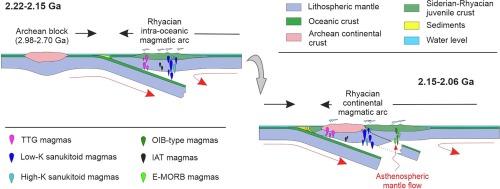Coeval TTG and sanukitoid magmatism during the Rhyacian tectonic evolution of the Juiz de Fora Complex (São Francisco Paleocontinent, SE-Brazil)
IF 3.2
2区 地球科学
Q2 GEOSCIENCES, MULTIDISCIPLINARY
引用次数: 0
Abstract
Transitioning tectonic regimes from stagnant lid to plate tectonic models is still challenging. This tectonic transition appears to be diachronic in different old cratonic blocks worldwide. One key point to address tectonic models in early Earth is the appearance of the TTG-sanukitoid associations, which are interpreted as the products of melting oceanic slabs and melting of the hydrated mantle wedge in supra subduction zones. Although typical of the Archean, this association persists until the Paleoproterozoic in some cratonic remnants of South America. The Minas-Bahia Orogen (MBO) is one of the most extensive Paleoproterozoic belts of Brazil, cropping out in the São Francisco Craton but also as reworked thrust slices within surrounding Neoproterozoic belts. Here, we explore the southern part of MBO, bringing new geochemical, U-Pb zircon geochronology (LA-ICP-MS) and Nd and Sr isotopic data of the Juiz de Fora Complex that constitutes the external magmatic arc system of this Siderian to Orosirian orogen. Granodioritic to tonalitic orthogranulites with TTG geochemical signatures, crystallization ages of ca. 2.21 and 2.14 Ga, with positive εNdi (+2.9 to + 5.9) and 87Sr/86Sri ratios between 0.7022 and 0.7045; Quartz-dioritic to granodioritic orthogranulites with sanukitoid composition, displaying crystallization ages between ca. 2.21 and 2.18 Ga, with near-chondritic εNdi values of −2.43 to + 0.39, and 87Sr/86Sri ratios between 0.7076 and 0.7179. Integrating the new data with previously published analyses allows us to envisage a comprehensive tectonic evolution model starting in an intra-oceanic setting and progressively evolving to a continental magmatic arc environment along the Rhyacian period. Integrated geochronology data indicates coeval and continuous generation of TTG and sanukitoid magmas for 160 Myr. Initially, with more juvenile contribution (ca. 2.22–2.15 Ga), that evolves progressively to a more mature stage (2.15––2.06 Ga). Additionally, two groups of mafic rocks, with ages of ca. 2.16 (OIB-like) and ca. 2.14 Ga (E-MORB), fill the gap between these two stages and possibly reflect arc migration and upwelling of the asthenosphere. Finally, data suggests the operation of plate tectonic processes since the Rhyacian, within this accretionary segment of the MBO, that ultimately resulted in the building of the São Francisco Paleocontinent.

巴西东南部圣弗朗西斯科古大陆胡伊斯-德-福拉复合体(Juiz de Fora Complex)在流沙纪构造演化过程中的共生TTG和sanukitoid岩浆活动
从停滞盖层向板块构造模式过渡的构造体系仍然具有挑战性。在全球不同的古老板块中,这种构造过渡似乎是非同步的。解决早期地球构造模型的一个关键点是 TTG-sanukitoid 组合的出现,这些组合被解释为大洋板块熔化和超俯冲带水合地幔楔熔化的产物。虽然这种关联是典型的阿新世关联,但在南美洲的一些地壳残余中,这种关联一直持续到古新生代。米纳斯-巴伊亚造山带(MBO)是巴西最广阔的古近古生代带之一,不仅出现在圣弗朗西斯科克拉通,而且在周围的新近古生代带中作为再加工的推力切片出现。在此,我们对 MBO 的南部进行了探索,带来了 Juiz de Fora 复合体新的地球化学、U-Pb 锆石地质年代学(LA-ICP-MS)以及 Nd 和 Sr 同位素数据,该复合体构成了这一西德至奥罗西利亚造山带的外部岩浆弧系统。花岗闪长岩到绿泥石正长岩具有 TTG 地球化学特征,结晶年龄约为 2.21 和 2.14 Ga,εNdi 为正值(+2.9 到 +5.9),87Sr/86Sri 比值介于 0.7022 和 0.7045 之间。7045;石英闪长岩至花岗闪长岩正长岩,成分为三基性岩,结晶年龄约在 2.21 至 2.18 Ga 之间,εNdi 值为 -2.43 至 +0.39,87Sr/86Sri 比值在 0.7076 至 0.7179 之间,接近于软玉质。将新的数据与以前发表的分析结果相结合,我们可以设想出一个全面的构造演化模型,该模型始于洋内环境,并沿着流纹纪逐步演化为大陆岩浆弧环境。综合地质年代数据表明,TTG和sanukitoid岩浆共生且持续生成了160 Myr。最初,TTG和sanukitoid岩浆的生成较为稚嫩(约2.22-2.15 Ga),之后逐渐发展到较为成熟的阶段(2.15--2.06 Ga)。此外,年龄约为2.16(OIB-like)和约为2.14 Ga(E-MORB)的两组岩浆岩填补了这两个阶段之间的空白,可能反映了弧的迁移和星体层的上涌。最后,数据表明,在 MBO 的这一增生段内,自 Rhyacian 以来一直存在板块构造过程,最终导致了圣弗朗西斯科古陆的形成。
本文章由计算机程序翻译,如有差异,请以英文原文为准。
求助全文
约1分钟内获得全文
求助全文
来源期刊

Precambrian Research
地学-地球科学综合
CiteScore
7.20
自引率
28.90%
发文量
325
审稿时长
12 months
期刊介绍:
Precambrian Research publishes studies on all aspects of the early stages of the composition, structure and evolution of the Earth and its planetary neighbours. With a focus on process-oriented and comparative studies, it covers, but is not restricted to, subjects such as:
(1) Chemical, biological, biochemical and cosmochemical evolution; the origin of life; the evolution of the oceans and atmosphere; the early fossil record; palaeobiology;
(2) Geochronology and isotope and elemental geochemistry;
(3) Precambrian mineral deposits;
(4) Geophysical aspects of the early Earth and Precambrian terrains;
(5) Nature, formation and evolution of the Precambrian lithosphere and mantle including magmatic, depositional, metamorphic and tectonic processes.
In addition, the editors particularly welcome integrated process-oriented studies that involve a combination of the above fields and comparative studies that demonstrate the effect of Precambrian evolution on Phanerozoic earth system processes.
Regional and localised studies of Precambrian phenomena are considered appropriate only when the detail and quality allow illustration of a wider process, or when significant gaps in basic knowledge of a particular area can be filled.
 求助内容:
求助内容: 应助结果提醒方式:
应助结果提醒方式:


